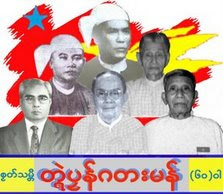The Burmese army will
not be able to eliminate the ethnic armed resistance in the country in
the same way the Sri Lankan military defeated the rebel Tamil Tiger
army because the geography in Burma is very different from that of Sri
Lanka, according to Ashely South while speaking at a meeting with the
Mon ethnic community in Sangkhlaburi, Kanchanaburi Province, Thailand
on July 27.
 |
Ashely South, who is an consultant of the Myanmar Peace Support Initiative (MPSI) based in Rangoon. (Photo: GMSUK) |
Despite some foreign academics saying that the Burmese army
will be able to wipe out the armed ethnic groups in the future, Ashely
South, a consultant of the Myanmar Peace Support Initiative (MPSI),
disagreed and identified that Burma has many ethnic armed groups,
whereas there was only one, the Tamil Tiger army, in Sri Lanka that
actively fought against the Sri Lankan government.
The armed ethnic groups in Burma
have bases along the border areas, from which they can widely defend
attacks from the Burmese army, and such barrier strongholds were not
part of the strategy of Sri Lanka’s Tamail Tigers.
Ashely South is the author of the book
Mon Nationalism and Civil War in Burma: The Golden Sheldrake
and for the past 20 years has worked with the Thailand Burma Border
Consortium (TBBC) in ethnic Mon and Karen areas along the Thai-Burmese
border.
Norway failed to solve
difficulties in the peace process in Sri Lanka despite having
established a peace working team in the country similar to the one they
recently established in Burma. The Sri Lankan government wiped out the
Tamil Tigers in 2009 when they launched heavy military offensives
against the rebel group even though they faced condemnation from the
international community for human rights abuses.
After Norwegian State Secretary
Torgeir Larsen visited Burma in May and met with the Burmese
government, Norway established an office of the MPSI in Rangoon that is
working for peace inside Burma. Aung Min, a principal peace negotiator
from Naypyidaw, requested such action from the Norwegian government
during a visit to the European country in April.
Currently the MPSI chiefly works
with the peace process in the Burma through mutual cooperation with
the Burmese government and the ethnic armed groups.
Ashely South said that it is too
early to say that real peace can reach Burma because his organization
has only just begun working to help settle the people in Tenasserim
Division and Pegu Division at Kyauk Gyi Township who have suffered from
the fighting in these conflict areas.
However, he said that he has
found some officials from the Burmese government to hold the belief
that the ethnic conflict can be solved by promoting development in the
ethnic areas. These areas have remained underdeveloped for many years
and some officials believe this is what initiated the armed struggle
and opposition to the central government.
Different ethnic armed groups
have urged the Burmese government to hold nationwide ceasefire
agreements and stop the destructive fighting in Kachin State.
“Fighting can start in the country at any time,” said Ashely South,
“and we do not know how long our project can last because the
government has not stopped fighting in places like Kachin State despite
the ethnic armed groups having asked them to stop,”
Feedback From
Thu, Aug 2, 2012 at 2:49 PM
Name of sender: Lyih Dane
Email of sender:
COMMENTS: The elimination of the
Tamil Tiger by the Sri Lankan government was the one-off. In reality, it
is not that easy to wipe out long established rebels such as those in
Burma. Given the aggressive mentality of the Tatmadaw, it would have
done so years ago if it could. There are also those, including NLD’s Daw
Suu, who against the idea of wiping out the rebels and the use of
violence to solve political problems. As a result, different approaches
have been taken by the authority. As we all know, the most successful
strategy so far is to make peace with one and fight the other. Had
all-out war been started from all corners, this country would have
suffered dire





 5:53 AM
5:53 AM
 Kawzarblogger.sport.co
Kawzarblogger.sport.co



















 အင္းစိန္ေထာင္စစ္ေၾကာေရးစခမ္းအတြင္း
အထိန္းသိမ္းခံေနရသည့္ ဦးဇင္းေဇာ္လတ္ေခၚ အရွင္ဥကၠံသ သည္
ေထာင္အာဏာပိုင္မ်ားႏွိပ္စက္မွဳဒါဏ္ေၾကာင့္
ေက်ာက္ကပ္ေယာင္ေဝဒနာခံစားေနရေသာ္လည္း ေထာင္ ေဆးရံုတြင္
ေဆးဝါးကုသခြင့္မျပဳေသးဟု မိသားစုဝင္မ်ားမွေျပာပါသည္။ အရွင္ဥကၠံသ၏
က်န္းမာေရးအေျခအေနႏွင့္ပက္သက္ျပီး
အင္းစိန္ေထာင္စစ္ေၾကာေရးစခမ္းအတြင္း
အထိန္းသိမ္းခံေနရသည့္ ဦးဇင္းေဇာ္လတ္ေခၚ အရွင္ဥကၠံသ သည္
ေထာင္အာဏာပိုင္မ်ားႏွိပ္စက္မွဳဒါဏ္ေၾကာင့္
ေက်ာက္ကပ္ေယာင္ေဝဒနာခံစားေနရေသာ္လည္း ေထာင္ ေဆးရံုတြင္
ေဆးဝါးကုသခြင့္မျပဳေသးဟု မိသားစုဝင္မ်ားမွေျပာပါသည္။ အရွင္ဥကၠံသ၏
က်န္းမာေရးအေျခအေနႏွင့္ပက္သက္ျပီး 
























